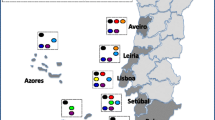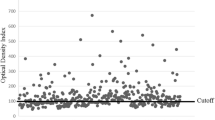Abstract
Canine Lyme borreliosis is one of the most common tick-transmitted diseases in the world. The infection is caused by spirochetal bacteria from the genus Borrelia burgdorferi. The principal vectors are various species of slow-feeding hard ticks of the Ixodes complex. Dogs are the most infected animals among the pets. The status of infection due to Borrelia in dogs remains unknown in many areas of Iran. Few studies have been reported on the distribution of this disease in the Iran dog’s population, so the aim of this survey was to evaluate the seroprevalence of Borrelia infection in companion dogs in Ahvaz district (southwestern Iran), from October 2011 to August 2013. In the present survey, a total of 168 companion dogs with different ages were examined for serum antibody detection against B. burgdorferi by immunochromatography assay (ICA) (catalog No. RB 21–22). The dogs were selected between referred cases to Veterinary Hospital of Shahid Chamran University of Ahvaz, southwestern Iran. They were classified according to age, sex, season, and region. The studied dogs were divided based on age into three groups (group 1, <1 year; group 2, 1–5 years; and group 3, >5 years) and based on area into five regions (north, east, west, south, and central). The results were analyzed by using chi-square analysis, Fisher’s exact test, and Z test. Sixteen out of 168 serum samples (9.52 %) had antibodies against B. burgdorferi (95 % CI for proportion, 5.1–13.9 %). Prevalence was significantly higher in adult dogs above 5 years (19.40 %; 13 out of 67) compared with dogs between 1 and 5 years (3.77 %; 2 out of 53) and less than 1 year (2.08 %; 1 out of 48) (P < 0.05). Prevalence was higher in male dogs (10.53 %; 10 out of 95) than in female dogs (8.22 %; 6 out of 73), in the season of summer (11.90 %; 5 out of 42) and west region (11.11 %; 4 out of 36), but the difference was not significant between the prevalence of infection relative to host gender, season, and region (P > 0.05). The results of the present study provide useful information on the epidemiology of Lyme diseases in this area, which until now was not studied. Our results emphasize the presence of tick-borne diseases and the need for public health interventions.
Similar content being viewed by others
References
Amusategui I, Tesouro MA, Kakoma I, Sainz A (2008) Serological reactivity to Ehrlichia canis, Anaplasma phagocytophilum, Neorickettsia risticii, Borrelia burgdorferi and Rickettsia conorii in dogs from northwestern Spain. Vector Borne Zoonotic Dis 8(6):797–803
Appel MJ, Allan S, Jacobson RH, Lauderdale TL, Chang YF, Shin SJ, Thomford JW, Todhunter RJ, Summers BA (1993) Experimental Lyme disease in dogs produces arthritis and persistent infection. J Infect Dis 167(3):651–664
Aslan Başbulut E, Gozalan A, Sonmez C, Coplu N, Korhasan B, Esen B, Akın L, Ertek M (2012) Seroprevalence of Borrelia burgdorferi and tick-borne encephalitis virus in a rural area of Samsun, Turkey. Mikrobiyol Bul 46(2):247–256
Barth C, Straubinger RK, Sauter-Louis C, Hartmann K (2012) Prevalence of antibodies against Borrelia burgdorferi sensu lato and Anaplasma phagocytophilum and their clinical relevance in dogs in Munich, Germany. Berl Munch Tierarztl Wochenschr 125(7–8):337–344
Berzina I, Matise I (2013) Seroprevalence against Borrelia burgdorferi sensu lato and occurence of antibody co-expression with Anaplasma phagocytophilum in dogs in Latvia. Ir Vet J 66(1):66–69
Carrade D, Foley J, Sullivan M, Foley CW, Sykes JE (2011) Spatial distribution of seroprevalence for Anaplasma phagocytophilum, Borrelia burgdorferi, Ehrlichia canis, and Dirofilaria immitis in dogs in Washington, Oregon, and California. Vet Clin Pathol 40(3):293–302
Ciceroni L, Bartoloni A, Ciarrocchi S, Pinto A, Guglielmetti P, Valdez Vasquez C, Gamboa Barahona H, Roselli M, Paradisi F (1997) Serologic survey for antibodies to Borrelia burgdorferi in sheep, goats and dogs in Cordillera province. Bolivia J Vet Med Series B 44(3):133–137
Egenvall A, Bonnett BN, Gunnarsson A, Hedhammar A, Shoukri M, Bornstein S, Artursson K (2000) Sero-prevalence of granulocytic Ehrlichia spp. and Borrelia burgdorferi sensu lato in Swedish dogs 1991–94. Scand J Infect Dis 32(1):19–25
Eng TR, Wilson ML, Spielman A, Lastavica CC (1988) Greater risk of Borrelia burgdorferi infection in dogs than in people. J Infect Dis 158(6):1410–1411
Galaviz-Silva L, Perez-Trevino KC, Molina-Garza ZJ (2013) Distribution of ixodid ticks on dogs in Nuevo Leon, Mexico, and their association with Borrelia burgdorferi sensu lato. Exp Appl Acarol 61(4):491–501
Gerber B, Eichenberger S, Wittenbrink MM, Reusch CE (2007) Increased prevalence of Borrelia burgdorferi infections in Bernese Mountain dogs: a possible breed predisposition. BMC Vet Res l12(3):15
Goossens HA, van den Bogaard AE, Nohlmans MK (2001) Dogs as sentinels for human Lyme borreliosis in The Netherlands. J Clin Microbiol 39(3):844–848
Greene CE, Straubinger RK (2006) Borreliosis. In: Infectious diseases of the dog and cat. Green CE (ed); Saunders, Philadelphia, USA, PP:417–435
Guerra MA, Walker ED, Kitron U (2001) Canine surveillance system for Lyme borreliosis in Wisconsin and northern Illinois: geographic distribution and risk factor analysis. Am J Trop Med Hyg 65:546–552
Hanifeh M, Malmasi A, Virtala AKM, Nikbakht-Brujeni GR, Zahraei Salehi T, Rahbari S (2012) Seroprevalence, geographic distribution and risk factor analysis of Borrelia burgdorferi sensulato in naturally exposed dogs of Iran. Afri J Microbiol Rec 6(25):5353–5361
Hinrichsen VL, Whitworth UG, Breitschwerdt EB, Hegarty BC, Mather TN (2001) Assessing the association between the geographic distribution of deer ticks and seropositivity rates to various tick-transmitted disease organisms in dogs. J Am Vet Med Assoc 218(7):1092–1097
Levy SA (2002) Use of a C6 ELISA test to evaluate the efficacy of wholecell bacteria for the prevention of naturally transmitted canine Borrelia burgdorferi infection. Vet Therap 3:420–424
Mannelli A, Cerri D, Buffrini L, Rossi S, Rosati S, Arata T, Innocenti M, Grignolo MC, Bianchi G, Iori A, Tolari F (1999) Low risk of Lyme borreliosis in a protected area on the Tyrrhenian coast, in central Italy. Eur J Epidemiol 15(4):371–377
Mircean V, Dumitrache MO, Györke A, Pantchev N, Jodies R, Mihalca AD, Cozma V (2012) Seroprevalence and geographic distribution of Dirofilaria immitis and tick-borne infections (Anaplasmapha gocytophilum, Borrelia burgdorferisensulato, and Ehrlichia canis) in dogs from Romania. Vector Borne Zoonotic Dis 12(7):595–604
Nadelman RB, Wormser GP (1998) Lyme Borreliosis. Lancet 352(9127):557–565
Nekoei H, Asmar M (1996) Distribution of borreliosis in Iran. The 3rd National Congress of Zoonoses in Iran, Mashhad, Iran, PP:23–25
Nielssen A, Carr A, Heseltine J (2002) Update on canine Lyme disease. Vet Med 1:604–609
Pantchev N, Schaper R, Limousin S, Norden N, Weise M, Lorentzen L (2009) Occurrence of Dirofilaria immitis and tick-borne infections caused by Anaplasma phagocytophilum, Borrelia burgdorferi sensu lato and Ehrlichia canis in domestic dogs in France: results of a countrywide serologic survey. Parasitol Res 105(1):1501–1502
Paster BJ, Dewhirst FE (2000) Phylogenetic foundation of spirochetes. J Mol Microbiol Biotechnol 2(4):341–344
Pejchalova K, Zakovska A, Fucik K, Schanilec P (2006) Serological confirmation of Borrelia burgdorferi infection in dogs in the Czech Republic. Vet Res Commun 30(3):231–238
Rostami A, Zaeemi M, Piazhak N, Mazaheri Nezhad R (2011) A case report of atypical borreliosis in dog. IJVST 3(2):49–55
Savic S, Vidic B, Lazic S, Lako B, Potkonjak A, Lepsanovic Z (2010) Borrelia burgdorferi in ticks and dogs in the province of Vojvodina, Serbia. Parasite 17(4):357–361
Steere AC, Coburn J, Glickstein L (2004) The emergence of Lyme disease. J Clin Invest 113(8):1093–1101
Stefançikova A, Tresova G, Petko B, Skardova I, Sesztakova E (1998) Elisa comparison of three whole-cell antigens of Borrelia burgdorferi sensu lato in serological study of dogs from area of Kosice, eastern Slovakia. Ann Agric Environ Med 5(1):25–30
Tabatabaie P, Siadati A (2006) A case of Lyme disease (Lyme Borreliosis). TUMS 44(3):222–224
Tilley LP, Smith FWK (2000) The 5-minute veterinary consult, canine and feline. Second Edition, Lipincott Williams and Wilkins, PP:368–412
Vahedi-Noori N, Rahbari S, Bokaei S (2012) The seasonal activity of Ixodes ricinus tick in Amol, Mazandaran province, Northern Iran. J Arthropod Borne Dis 6(2):129–135
Wagner B, Erb HN (2012) Dogs and horses with antibodies to outer-surface protein C as on-time sentinels for ticks infected with Borrelia burgdorferi in New York State in 2011. Prev Vet Med 107(3–4):275–279
Wang G, van Dam AP, Schwartz I, Dankert J (1999) Molecular typing of Borrelia burgdorferi sensu lato: taxonomic, epidemiological, and clinical implications. Clin Microbiol Rev 12:633–653
Author information
Authors and Affiliations
Corresponding author
Rights and permissions
About this article
Cite this article
Mosallanejad, B., Avizeh, R., Jalali, M.H.R. et al. A serological survey on Borrelia burgdorferi infection among companion dogs in Ahvaz district, southwestern Iran. Comp Clin Pathol 24, 1559–1563 (2015). https://doi.org/10.1007/s00580-015-2116-x
Received:
Accepted:
Published:
Issue Date:
DOI: https://doi.org/10.1007/s00580-015-2116-x




